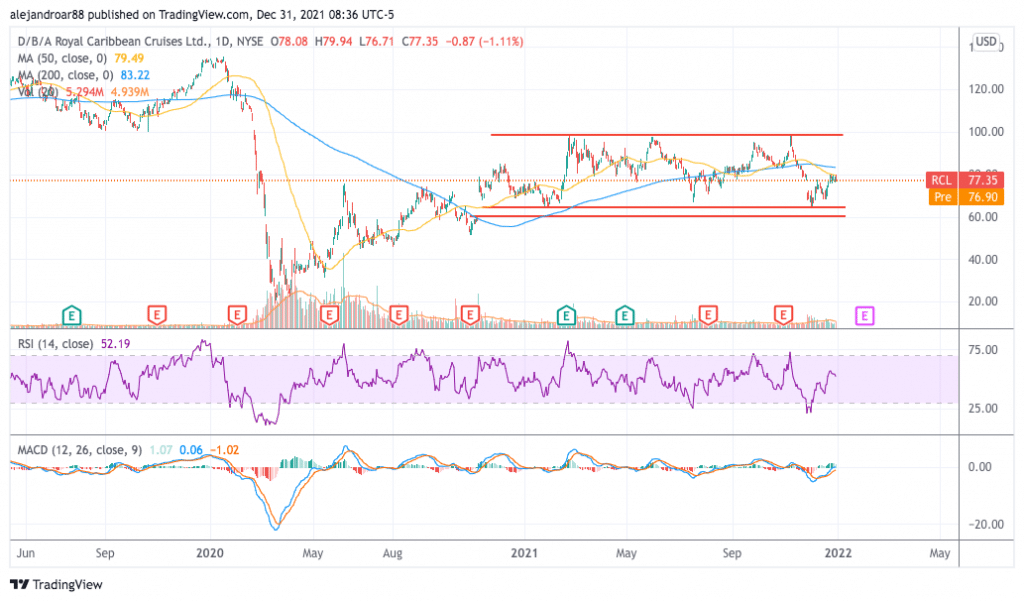Royal Caribbean Stock Up 11% in December – Time to Buy Royal Caribbean Stock?
Please note that we are not authorised to provide any investment advice. The content on this page is for information purposes only.
The price of Royal Caribbean stock is up 11% so far this month despite the threat that the omicron variant of the COVID-19 virus presents to the financial recovery of this cruise operator.
Just yesterday, the US Centers for Disease Control and Prevention (CDC) changed its guidelines regarding cruise ship travels and encouraged passengers to avoid this activity altogether “regardless of vaccination status”.
The agency qualified cruise ship travel as a Level 4 activity, meaning that the risk of contracting the virus is “very high”.
The CDC cited the appearance of the omicron variant as the leading cause for this change in the risk level assigned to cruise ship travel. However, the agency did not move to ban cruise trips altogether – something that they did back in 2020 once the pandemic broke.
The market did not react positively to the news as all cruise line stocks experienced a decline during yesterday’s stock trading session. However, the decline was quite mild as investors expect that these guidelines should not prevent these companies from fully recovering to pre-pandemic levels next year.
In regards to the company’s performance in this particular scenario, Royal Caribbean stated that even though omicron is having a “big short-term impact on everyone”, the level of severity of the cases that have tested positive has been “significantly milder”.
The company now expects to experience a decline in bookings and higher cancellations for short-term sailings. Meanwhile, load factors for the first semester of 2022 are expected to remain below historical levels in line with the market’s expectations.
“We expect these factors to have a negative impact in the short term but are optimistic they will lead us to a more pervasive but less severe health environment.”, stated Richard Fain, Chief Executive Officer for Royal Caribbean.
He concluded: “Taken together, this should enable us to produce a strong transitional year in 2022 and a very strong 2023.”
What could be expected from this travel stock after these developments? In this article, I’ll be assessing the price action and fundamentals of Royal Caribbean stock to outline plausible scenarios for the future.
67% of all retail investor accounts lose money when trading CFDs with this provider.
Royal Caribbean Stock – Technical Analysis

This month’s uptick in the price of Royal Caribbean stock is quite encouraging considering that the price action appears to be reacting to a double-bottom formation that emerged after RCL bounced from the $64.5 per share support area.
However, it remains to be seen if this surge will lead to another tag of the $100 level as the stock is still trading below its short-term and mid-term moving averages.
This guideline from the CDC is not necessarily a negative catalyst for the stock as the market was already pricing some sort of struggle in the company’s recovery during the first two quarters of 2022.
With this in mind, the short-term impact of this development should be relatively mild and this means that the price may continue its upward trajectory in the following days unless omicron turns out to be deadlier than expected.
Momentum indicators are favoring this view as the Relative Strength Index (RSI) remains on an uptrend at 52.2 (bullish) while the MACD is surging to positive territory and above the signal line.
Moving forward, if the price breaks above the 200-day simple moving average – currently standing at $83 per share – chances are that the price of Royal Caribbean stock could retest the $100 level soon.
Royal Caribbean Stock – Fundamental Analysis
Royal Caribbean’s long-term debt has continued to climb this year and currently stands at nearly $20 billion as the company’s cash burn rate remains elevated.
During the first nine months of 2021, the company reported $3.3 billion in negative free cash flows. However, the firm expects to swing to profitability and positive free cash flows by the end of the full 2022 fiscal year.
Both the market’s and the management’s expectations are that 2022 will be a strong year for the cruise operators. With this in mind, investors should remain vigilant about any development that could lead to a change in this consensus scenario such as the appearance of a more severe and deadlier variant or one that is resistant to vaccines.
Since that doesn’t appear to be the case for omicron, the upward trajectory of the price at the moment might not be affected by the spread of this variant.
At the current price of $77.4 per share, Royal Caribbean is trading at more than 70 times its forecasted adjusted earnings per share for 2022.
It remains to be seen if the company will be able to recover to the levels of profitability seen before the pandemic – around $9 per share on a fully diluted basis – as interest expenditures may weigh heavily on the firm’s bottom-line performance.
In the past 12 months, these expenditures have amounted to $1.3 billion compared to the $381 million the firm paid before the virus crisis.
Based on Royal’s net income before the contingency, these higher financial expenses may lead to a 50% drop in its profitability meaning that, even if the firm recovers to pre-pandemic levels, its profit-generation capacity will remain severely affected.
Additionally, the company’s balance sheet is not as strong as that of other players in the industry as cash and equivalents stood at $3.3 billion by the end of the previous quarter. This amount could surely help the firm in withstanding the crisis until sales move back to pre-pandemic levels but there will be little left off to pay the huge amount of debt that Royal Caribbean now owes.
Assuming that the firm will generate earnings of around $4 per share in 2023 and forward, a 19x forward P/E multiple seems rather stretched for a company as leveraged as Royal Caribbean.
With this in mind, the upside potential for the stock seems limited while the downside risk is not necessarily mild considering the uncertain paths that the pandemic could take in the following quarters.






